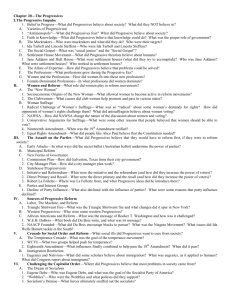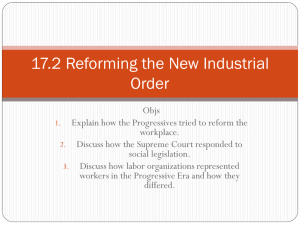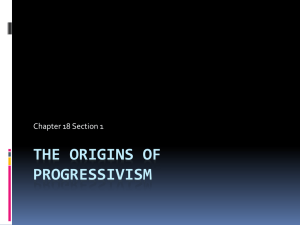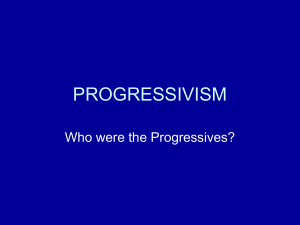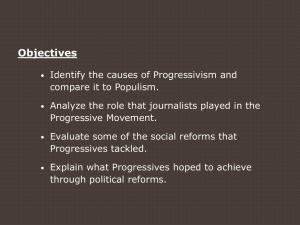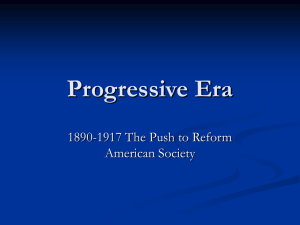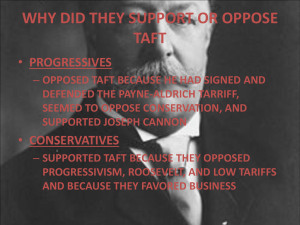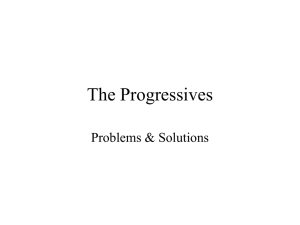Chapter 20
advertisement
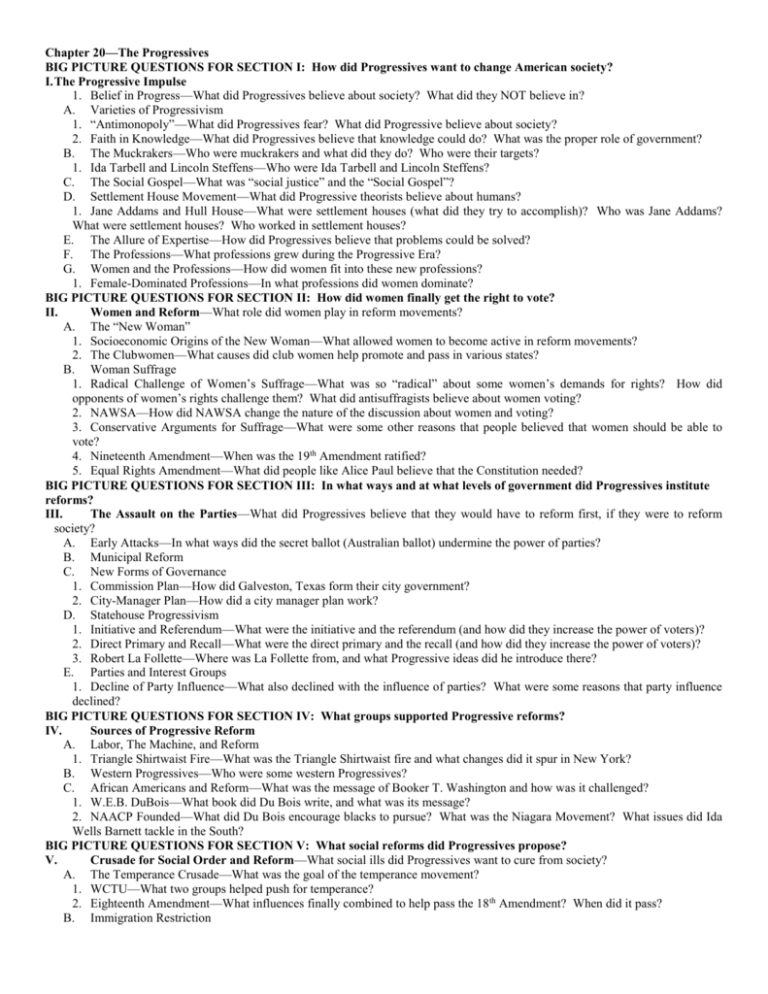
Chapter 20—The Progressives BIG PICTURE QUESTIONS FOR SECTION I: How did Progressives want to change American society? I. The Progressive Impulse 1. Belief in Progress—What did Progressives believe about society? What did they NOT believe in? A. Varieties of Progressivism 1. “Antimonopoly”—What did Progressives fear? What did Progressive believe about society? 2. Faith in Knowledge—What did Progressives believe that knowledge could do? What was the proper role of government? B. The Muckrakers—Who were muckrakers and what did they do? Who were their targets? 1. Ida Tarbell and Lincoln Steffens—Who were Ida Tarbell and Lincoln Steffens? C. The Social Gospel—What was “social justice” and the “Social Gospel”? D. Settlement House Movement—What did Progressive theorists believe about humans? 1. Jane Addams and Hull House—What were settlement houses (what did they try to accomplish)? Who was Jane Addams? What were settlement houses? Who worked in settlement houses? E. The Allure of Expertise—How did Progressives believe that problems could be solved? F. The Professions—What professions grew during the Progressive Era? G. Women and the Professions—How did women fit into these new professions? 1. Female-Dominated Professions—In what professions did women dominate? BIG PICTURE QUESTIONS FOR SECTION II: How did women finally get the right to vote? II. Women and Reform—What role did women play in reform movements? A. The “New Woman” 1. Socioeconomic Origins of the New Woman—What allowed women to become active in reform movements? 2. The Clubwomen—What causes did club women help promote and pass in various states? B. Woman Suffrage 1. Radical Challenge of Women’s Suffrage—What was so “radical” about some women’s demands for rights? How did opponents of women’s rights challenge them? What did antisuffragists believe about women voting? 2. NAWSA—How did NAWSA change the nature of the discussion about women and voting? 3. Conservative Arguments for Suffrage—What were some other reasons that people believed that women should be able to vote? 4. Nineteenth Amendment—When was the 19th Amendment ratified? 5. Equal Rights Amendment—What did people like Alice Paul believe that the Constitution needed? BIG PICTURE QUESTIONS FOR SECTION III: In what ways and at what levels of government did Progressives institute reforms? III. The Assault on the Parties—What did Progressives believe that they would have to reform first, if they were to reform society? A. Early Attacks—In what ways did the secret ballot (Australian ballot) undermine the power of parties? B. Municipal Reform C. New Forms of Governance 1. Commission Plan—How did Galveston, Texas form their city government? 2. City-Manager Plan—How did a city manager plan work? D. Statehouse Progressivism 1. Initiative and Referendum—What were the initiative and the referendum (and how did they increase the power of voters)? 2. Direct Primary and Recall—What were the direct primary and the recall (and how did they increase the power of voters)? 3. Robert La Follette—Where was La Follette from, and what Progressive ideas did he introduce there? E. Parties and Interest Groups 1. Decline of Party Influence—What also declined with the influence of parties? What were some reasons that party influence declined? BIG PICTURE QUESTIONS FOR SECTION IV: What groups supported Progressive reforms? IV. Sources of Progressive Reform A. Labor, The Machine, and Reform 1. Triangle Shirtwaist Fire—What was the Triangle Shirtwaist fire and what changes did it spur in New York? B. Western Progressives—Who were some western Progressives? C. African Americans and Reform—What was the message of Booker T. Washington and how was it challenged? 1. W.E.B. DuBois—What book did Du Bois write, and what was its message? 2. NAACP Founded—What did Du Bois encourage blacks to pursue? What was the Niagara Movement? What issues did Ida Wells Barnett tackle in the South? BIG PICTURE QUESTIONS FOR SECTION V: What social reforms did Progressives propose? V. Crusade for Social Order and Reform—What social ills did Progressives want to cure from society? A. The Temperance Crusade—What was the goal of the temperance movement? 1. WCTU—What two groups helped push for temperance? 2. Eighteenth Amendment—What influences finally combined to help pass the 18 th Amendment? When did it pass? B. Immigration Restriction 1. Eugenics and Nativism—What did some scholars believe about immigration? What was eugenics, as it applied to humans? What did Congress report about immigrants? BIG PICTURE QUESTIONS FOR SECTION VI: How did Progressives address economic issues? VI. Challenging the Capitalist Order—Where did Progressives believe that most problems in society came from? A. The Dream of Socialism 1. Eugene Debs—Who was Eugene Debs, and what was the goal of the Socialist Party of America? 2. “Wobblies”—Who were the Wobblies and what policies did they support? 3. Socialism’s Demise—What forces ultimately snuffed out the socialists? B. Decentralization and Regulation—What did most Progressives believe that the federal government should do? 1. The Problem of Corporate Centralization—Who was Louis Brandeis and what did he claim was the problem with corporations? What should government do? BIG PICTURE QUESTIONS FOR SECTION VII: How did Teddy Roosevelt reform the American Presidency? VII. Theodore Roosevelt (TR) and the Modern Presidency A. The Accidental President—How did TR become president? 1. Roosevelt’s Background—What was TR’s background? B. Government, Capital, and Labor 1. Roosevelt’s Vision of Federal Power—What type of Progressives did TR ally himself with? What should the role of government be? 2. Northern Securities Company—What was the Northern Securities case about, and what was the result? How did Roosevelt differ in the way the federal government intervened in labor affairs? C. The “Square Deal”—What was TR’s “Square Deal”? 1. Hepburn Act—What did the Hepburn Act set out to do? 2. Pure Food and Drug Act—What was The Jungle, who wrote it, and what action did it spur TR to take? D. Roosevelt and Conservation—How did TR act on conservation issues? E. Roosevelt and Preservation—How did “conservation” and “preservation” differ, and which did TR prefer? F. The Hetch Hetchy Controversy G. The Panic of 1907 1. Tennessee Coal and Iron Company—How did J.P. Morgan try to help end the Panic of 1907? What was TR’s role? BIG PICTURE QUESTIONS FOR SECTION VIII: How did arguments within the Republican Party develop? VIII. The Troubled Succession—Who did TR pick to succeed him as president? A. Taft and the Progressives 1. Payne-Aldrich Tariff—What did the Payne-Aldrich Tariff do, and what did Progressives think of it? 2. Ballinger-Pinchot Dispute—What happened during the Ballinger-Pinchot dispute that made Progressives end up hating Taft? B. The Return of Roosevelt 1. “New Nationalism”—Where had TR been? What was TR’s goal for the federal government (and the president) under the “New Nationalism”? C. Spreading Insurgency—What two events convinced TR to run for president again? D. Roosevelt Versus Taft—What happened when TR tried to get the Republican Party nomination? 1. The Progressive Party—What did TR and his supporters do (and how was a moose involved)? BIG PICTURE QUESTIONS FOR SECTION IX: How did Woodrow Wilson continue the Progressive tradition as president? IX. Woodrow Wilson and the New Freedom A. Woodrow Wilson 1. Wilson’s “New Freedom”—What was Wilson’s background in politics? How did Wilson’s plan of “New Freedom” contrast with TR’s view of government in the “New Nationalism”? Who won the election of 1912 (and why)? B. The Scholar as President 1. Lowering the Tariff—What did Progressives believe that the Underwood-Simmons Tariff would do? What did the Sixteenth Amendment do? 2. Federal Reserve Act—What did the Federal Reserve Act do? What did the Federal Trade Commission Act do? What did the Clayton Antitrust Act do? C. Retreated and Advance—What groups did Wilson attempt to help in the second half of his first term? 1. Child-Labor Laws—What did Wilson attempt to do to regulate child labor?

